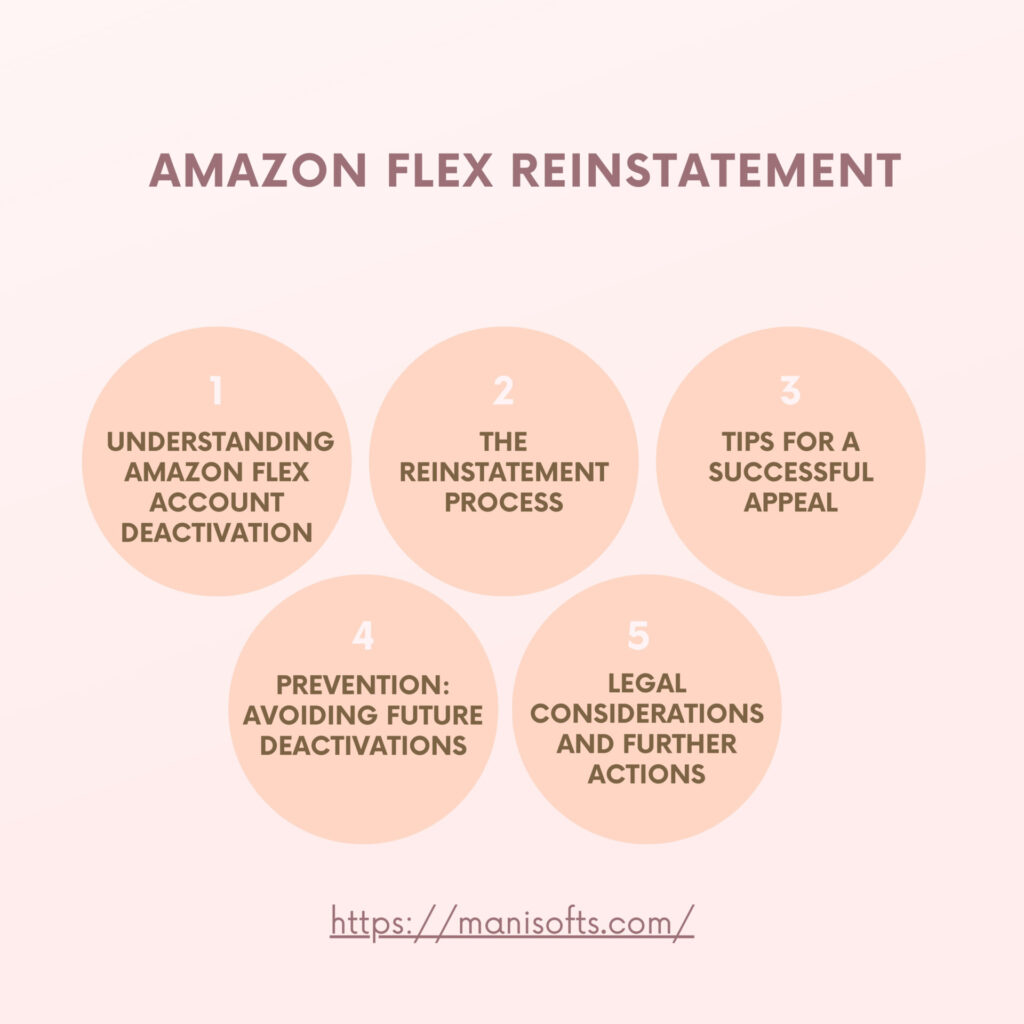Explore the essential guide to Amazon Flex reinstatement. Learn how to understand the reasons behind account deactivation, effectively appeal the decision, and take proactive steps to regain your status as an Amazon Flex driver. Gain insights on crafting a compelling appeal and tips to avoid future issues.
Introduction
Navigating the complexities of Amazon Flex reinstatement can be a daunting process for drivers who have had their accounts deactivated. Understanding the reasons behind the deactivation and knowing how to effectively appeal the decision is crucial for drivers looking to regain their active status. This guide will provide an overview of the common causes of account deactivation, outline the steps necessary for submitting a successful appeal, and offer practical tips for maintaining good standing with Amazon Flex. Whether you’re a seasoned driver or new to the platform, understanding these procedures can help ensure that you’re prepared to handle account issues and continue delivering with confidence.
Amazon flex reinstatement
To seek reinstatement for an Amazon Flex account, it’s essential to understand the reasons behind the deactivation and the specific steps Amazon outlines for appealing the decision. Here’s a general guideline on how to proceed:

1. Understanding Amazon Flex Account Deactivation
Amazon Flex, like other gig economy platforms, has specific standards to ensure quality, safety, and reliability. Drivers can face deactivation for the following reasons:
- Canceling Amazon Flex Blocks on Short Notice: On the first note, Amazon Flex is under a tightly scheduled logistics system where its drivers pick blocks of time to deliver. If a driver cancels that block late, it disrupts the entire delivery system as there might not be enough time to reassign that block to another driver. This results in delayed deliveries and hence customer dissatisfaction, and any late cancellation is fined and repeated leads to deactivation.
- Missing Blocks: More so, a commitment to a block’s completion and then failure to report for work without notice is not only unprofessional but also unreliable. Such may result in the delivery of packages due from Amazon, which may translate to poor client feedback, making the service rendered inefficient. Multiple recurrence of such action is adequate cause for deactivation.
- Using Block Grabbers and Bots: Using automated software drivers might try to quickly grab the most rewarding delivery blocks with the help of special utilities that are unattainable to others. Not only it contradict Amazon’s fair play principles, but it also eliminates fair distribution of delivery opportunities among all drivers. Conducting this way of grabbing is forbidden and will result in your immediate deactivation.
- Zero Tolerance Violations: Zero tolerance in regard to illegal activities: these actions include driving under alcohols or drugs influence, theft, and similar criminal violations. As these activities severely endanger others’ safety and are illegal per se, you would be permanently deactivated from the Amazon Flex program.
- Improper Delivery Practices: Inconsistent package delivery to wrong addresses, packages being mishandled and instructions for delivery not being followed all contribute to poor service credibility. The factors listed above are assessed by Amazon to determine driver productivity, and failing them is grounds for dismissal due to multiple failures. how how how how how how how how how how how .
- Passenger Policy Violations: Most Amazon Flex policy prohibits drivers from being accompanied by a passenger during the delivery block. The courses of such violation involve safety concerns and interference with operations, leading to deactivation.
- Using Multiple Gig Economy Apps Simultaneously: ° Amazon requires drivers to prioritize Flex deliveries during blocks at all times. Other gig economy apps during scheduled blocks can cause divided attention and lower service quality; deactivation could occur if caught. *
- Inactivity: If a driver goes for a long time without accepting any delivery blocks, the account could be considered inactive. As mentioned above, such an indication could mean that the driver has lost interest in operating as a driver with them, as such the only reason to reactivate it would be so that the resources can be freed up for those who are active. How.
- Outdated Documentation: Clients must assure that drivers hold a valid driving license, vehicle insurance, and registration at all times. Similarly, drivers are required to keep their documents updated, and if not, it is classified as an illegal activity, which can lead to driver deactivation.
- Harassment Policy Violations: Amazon does not tolerate any type of harassment of customers, other drivers, or Amazon staff. This includes discrimination or creating a hostile environment. Violating such a rule may result in being immediately deactivated from the program
- Fraud: Perpetrating hows in the form of falsely claiming the delivery of a package when it was not made, theft of packages as well as altering of any type of documentation in delivery causes undermining of the integrity of the service. Amazon follows up these infringements vigorously subsequently leading to deactivation.
- Selfie Verification Issues: Amazon Flex requires selfie verification regularly to verify who is making the delivery. It is a red light alluding to an unsafe person. Candidates who are up to no good may skip the given tasks. Deactivations may follow, prompting you to worry if it is still safe.
- Customer Complaints: Similarly, an elevated number of customer complaints regarding a driver’s behavior, delivery trends, or service excellence might result in Amazon assessing the situation. Upon confirmation that these complaints are real and show a typical profile of bad service, Amazon would deactivate the driver to preserve its pattern of service.
2. The Reinstatement Process
The reinstatement process requires patience and a strategic approach. Here’s what it generally involves:
- Initial Notification: After deactivation, Amazon sends an email with the specific reasons for deactivation. This email provides essential details and often mentions whether the decision can be appealed. If no email is received, you should check the Amazon Flex app for status updates or contact Amazon’s support.
- Review the Appeal Process: Follow the instructions provided in the email or app, as these outline the appeal process. This usually involves sending an email or filling out an online form. Pay close attention to the provided guidelines and deadlines to ensure your appeal is considered.
- Prepare Your Appeal: Carefully prepare your response:
- Understand the Reason: Understand why Amazon deactivated your account.
- Gather Evidence: Collect all relevant data, like delivery logs, communication records, and customer feedback.
- Craft a Response: Draft a concise yet comprehensive explanation of why the deactivation was an error or unjust. Be honest and acknowledge any mistakes, providing an actionable improvement plan.
- Submit the Appeal: Send your appeal through the outlined channels. Make sure you follow the required format and include all necessary attachments.
- Wait for Decision: The review process may take several weeks. Amazon’s decision will come via email or through the app. Be prepared for additional follow-up questions.
3. Tips for a Successful Appeal
- Be Professional: Treat the appeal process like a job interview. Maintain a respectful tone, even if frustrated.
- Be Concise: Make your points clear and relevant. Avoid long-winded explanations that obscure your primary message.
- Be Honest: Own up to any mistakes. A genuine acknowledgment of the issue and a clear plan for rectification is often better received.
- Be Proactive: Demonstrate a proactive commitment to improvement, whether that’s additional training, route planning, or time management skills.
4. Prevention: Avoiding Future Deactivations
To avoid repeating the experience of deactivation, consider these preventive measures:
- Understand the Rules: Familiarize yourself with Amazon Flex’s policies and community guidelines. This reduces unintentional violations.
- Stay Organized: Use reliable tools for scheduling, routing, and time management. Staying organized ensures consistent on-time deliveries.
- Communicate Issues: If a problem arises—like a delayed delivery or unresponsive customer—contact Amazon support immediately.
- Learn from Feedback: Consider customer and Amazon feedback as constructive criticism and adjust your practices accordingly.
5. Legal Considerations and Further Actions
If your appeal is denied or you believe the deactivation was fundamentally unjust, further actions can include:
- Consult Legal Advice: A lawyer familiar with labor or contract law may offer guidance on whether your deactivation violates any rights or agreements.
- Seek Community Support: Forums and social media groups can provide support, with members sharing advice based on their experiences.
Outcome of the Reinstatement Application
The result of the reinstatement operations can turn out to be of utmost importance for your future profession or science. On the one hand, it might be reinstated membership in the relevant professional organization. On the other hand, the application outcomes may affect your reacquiring license activity or enrollment in the educational program. Below, you can find guidance on what to expect from the possible resulting scenarios and which of the following measures can be applied after the decision.
Understanding Possible Outcomes
Most decision on reinstatement applications can generally be categorized into one of three classes:
- Approval: Finally, your reinstatement application has been approve. Your restored status, license or membership.
- Conditional Approval: Reinstatement with specific conditions or probation Probation is a process through which your reinstatement may give you a status conditional upon your fulfilled obligation. Your reinstatement means that you also have a reinstated probation or conditional term with the subsequent set of obligations.
- Denial: The application has been declined, and your status is still canceled or suspended.
Dealing with Each Scenario
If Your Application is Approved
- Review the Details: Either way, make sure you get an understanding of any new rules, guidelines, or requirements of your reinstated status.
- Acknowledge Receipt and Acceptance: Kindly let me know if you have received this email and confirm your acceptance of your reinstatement. If there are any conditions attached to the reinstatement that I have missed. Secondly, in case there is anything that I need to address, please inform me.
- Re-integrate: Take proactive steps to reintegrate yourself into the professional or academic environment. This may involve attending meetings, updating professional profiles, or engaging with ongoing projects or courses.
If You Receive Conditional Approval
- Understand the Conditions: Carefully review any conditions or probationary terms tied to your reinstatement. It is important to fully understand what is expected of you during the probationary period.
- Compliance: Adhere strictly to the conditions set forth in the approval. This may involve periodic reporting, attending counseling sessions, or undertaking additional training.
- Document Your Compliance: Keep detailed records of your adherence to the set conditions. This documentation can be crucial in future evaluations of your status.
If Your Application is Denied
- Request Detailed Reasons: If not already provided, ask for a detailed explanation of why your application was denied. This information is key for any future attempts at reinstatement.
- Consider an Appeal: If you believe that your application was unjustly denied or that not all information was considered, look into the possibility of an appeal. Make sure you understand the appeal process and the timeline for submitting an appeal.
Plan for the Future: If an appeal is not feasible or successful, consider alternative paths. This might involve seeking similar status at a different institution or organization or pursuing additional qualifications or experiences required for future reinstatement.
FAQ’s
Send an email to the following address if you’d like to appeal a permanent deactivation from Amazon Flex be aware that this process is only applicable to permanent deactivations and not temporary ones: [email protected].
Please note that you can have only one Amazon Flex account. If you intend to be a driver, you will have to contact the Amazon Flex team to request the reactivation of your account. Additionally, you asked about the chances of commencing work after being terminated at Amazon Flex. If you were fired from Flex as a result of a Category 1 offense, it is improbable that you would be hired again.
Please submit an elaborate explanation, or relevant documents supporting such claims that your account adhered to our policy on Restricted Products.
How to Submit Your Amazon Flex Appeal: Once you have prepared a brief appeal letter after the Amazon Flex deactivation process, you will need to attach it alongside the attached support documents to show your commitment in enhancing the delivery project. This way, you are now a step closer to being reinstated.
Plan of Action Letter The ‘Plan of Action’ letter will become relevant if Amazon allows you to present. In that case, you will be required to prepare a ‘Plan of Action,’ and then submit it. The elements of the Plan may differ depending on the suspended or denied types, but they should contain the proper solution to the address.
Conclusion
Applicants seeking to be reinstated in the Amazon Flex Program are required to follow a properly structured process when applying for reinstatement. Submitting appropriate documents that substantiate a dedication to compliance and improved services, a well-written appeal, and understanding the technicality of Amazon Flex’s policies are some of the significant aspects. However, there are no assurances of approval of reinstatement requests; following this metric closely is likely to enhance the return of applicants to the program. Overall, applicants must maintain professionalism, despair, and follow it up because this is likely to be a complex process for a successful return to the network as an opportunity to resume delivery functions.




